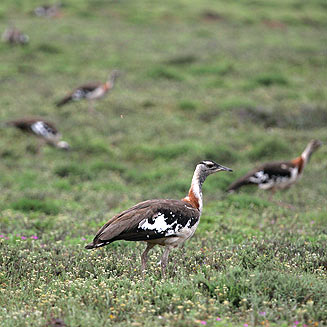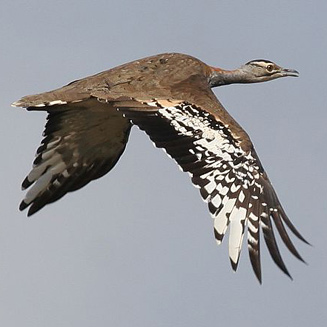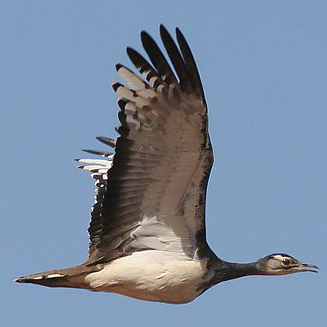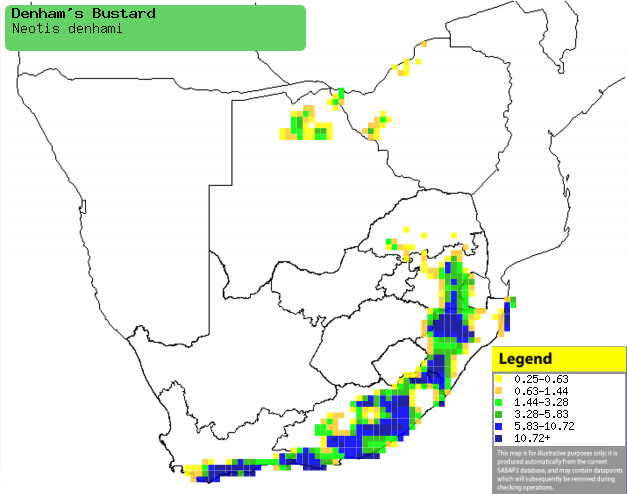|
Neotis denhami (Denham's bustard,
Stanley's bustard)
Veldpou [Afrikaans]; Iseme (generic term for bustard)
[Xhosa]; iSeme (generic term for bustard) [Zulu]; Epwezampundu (generic term for
bustard) [Kwangali]; Khupa (generic term for bustard) [South Sotho]; Kgôri,
Kgôrithamaga [Tswana]; Denham-trap [Dutch]; Outarde de Denham [French];
Stanleytrappe [German]; Abetarda-real [Portuguese]
Life
> Eukaryotes >
Opisthokonta
> Metazoa (animals) >
Bilateria >
Deuterostomia > Chordata >
Craniata > Vertebrata (vertebrates) > Gnathostomata (jawed
vertebrates) > Teleostomi (teleost fish) > Osteichthyes (bony fish) > Class:
Sarcopterygii (lobe-finned
fish) > Stegocephalia (terrestrial
vertebrates) > Tetrapoda
(four-legged vertebrates) > Reptiliomorpha > Amniota >
Reptilia (reptiles) >
Romeriida > Diapsida > Archosauromorpha > Archosauria >
Dinosauria
(dinosaurs) > Saurischia > Theropoda (bipedal predatory dinosaurs) >
Coelurosauria > Maniraptora > Aves
(birds) >
Order: Gruiformes
> Family: Otitidae
 |
 |
| Denham's bustard,
Addo Elephant National
Park, Eastern Cape, South Africa. [photo Duncan Robertson ©] |
Denham's bustards foraging,
Addo Elephant National
Park, Eastern Cape, South Africa. [photo Duncan Robertson ©] |
 |
 |
| Denham's bustard, Bredasdorp, South
Africa. [photo Trevor Hardaker ©] |
Denham's bustard, Bredasdorp, South Africa. [photo Trevor Hardaker ©] |
The Denham's bustard is widespread in the Afrotropics, from
western to southern Africa, where it is scarce to locally common in grassland,
fynbos and cultivated areas. It is omnivorous, feeding on a wide range of
animals, including grasshoppers, weevils, spiders, and even snakes, as well as
plant products, including grass, leaves and flowers. It is polygynous, the male
mating with multiple females, who will take on all the incubation and chick
rearing duties. It lays 1-2 eggs, which hatch after about 23-25 days. The chicks
are cared for by their mother, who will catch food and put into in front of the
chicks, although later they start foraging for themselves.
Distribution and habitat
Widespread in sub-Saharan Africa, excluding lowland forest
and deserts. In southern Africa it is locally common in southern and eastern
South Africa, while scarce in northern Botswana and north-eastern Zimbabwe. It breeds in
grassland and lowland fynbos, but in the non-breeding season it also strays into
cultivated fields of barley, cotton and clovers. It also occurs
in Nama karoo and sparse woodland.
|
 |
|
Distribution of Denham's bustard in southern Africa,
based on statistical smoothing of the records from first SA Bird Atlas
Project (©
Animal Demography unit, University of
Cape Town; smoothing by Birgit Erni and Francesca Little). Colours range
from dark blue (most common) through to yellow (least common).
See here for the latest distribution
from the SABAP2. |
Predators and parasites
Food
It is omnivorous, feeding on a wide range
of animals, including grasshoppers, weevils, spiders, and even snakes, as well
as plant products, such as grass, leaves and flowers. The following food items
have been recorded in its diet:
- Animals
- invertebrates
- vertebrates
- reptiles
- frogs
- birds' eggs and nestlings
- small rodents
- Plant matter
- grass
- leaves
- shoots
- stems
- roots
- flowers
- flowerheads
- Hypochoeris radicata (Cats-ear)
- Senecio coronatus (Ragwort)
- berries
Breeding
- Polygynous, with the male performing an elaborate courtship
display to attract females, some of which he mates with.
- The eggs are laid directly on the ground, with enough surrounding
vegetation to conceal the female when she is incubating.
- Egg-laying season is from September-December.
- It lays 1-2 eggs, which are incubated solely by the female for 23-25
days. She usually incubates for 82% of the day, only leaving the nest if she
needs to feed.
- The chicks are cared for by their mother, who will catch food and put
into in front of the chicks, although later they start foraging for
themselves.
Threats
Globally near-threatened, but vulnerable in South Africa,
largely due to habitat loss, snaring, poisoning, hunting and human disturbance.
For example, its population in the Gordon's Bay area in the Western Cape disappeared in
1937 due to construction of a road.
References
-
Hockey PAR, Dean WRJ and Ryan PG (eds) 2005. Roberts
- Birds of southern Africa, VIIth ed. The Trustees of the John Voelcker
Bird Book Fund, Cape Town.
|
